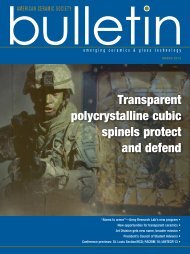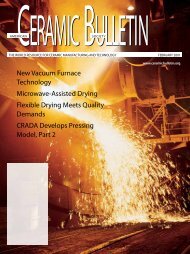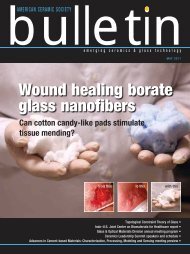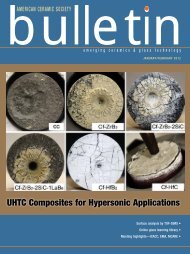AMERICAN CERAMIC SOCIETY
AMERICAN CERAMIC SOCIETY
AMERICAN CERAMIC SOCIETY
Create successful ePaper yourself
Turn your PDF publications into a flip-book with our unique Google optimized e-Paper software.
hot between pieces, and additional cost<br />
is saved by eliminating job-specific mold<br />
forms.<br />
The new approach allows for more<br />
precise control of the process. Rist says,<br />
“While the conventional process relies a<br />
great deal on trial and error, we simulate<br />
the process and the material behavior<br />
on a computer. We then compare the<br />
outcome with the results from physical<br />
tests so we can identify and implement<br />
the most favorable process conditions.”<br />
The Fraunhofer team has demonstrated<br />
the process on sheets of glass<br />
measuring approximately one meter<br />
square, a size that should be big enough<br />
for Gehry and other creative designers<br />
to work with.<br />
Visit http://www.fraunhofer.de n<br />
NSF releases more info on<br />
Materials Genome Initiative<br />
funding plans<br />
During his plenary presentation at<br />
MS&T’11, NSF director Subra Suresh<br />
mentioned several times that additional<br />
information would be forthcoming<br />
in regard to funding opportunities for<br />
the high-priority Materials Genome<br />
Initiate. In particular, Suresh alerted<br />
the audience to the imminent release<br />
of an NSF “Dear Colleague Letter” on<br />
the topic.<br />
The letter, “Designing Materials<br />
to Revolutionize and Engineer our<br />
Future,” has now been sent out and<br />
posted on the NSF website.<br />
Part of the emphasis in the DMREF<br />
letter, signed by Edward Seidel and<br />
Thomas Peterson, for the Mathematical<br />
and Physical Sciences and Engineering<br />
Directorates, respectively, is a call<br />
for developing common toolsets,<br />
which can be used across the entire<br />
materials discovery-to-deployment<br />
continuum. Seidel and Peterson specifically<br />
mention in the letter that the<br />
NSF is looking for tools that integrate<br />
“advanced computational methods with<br />
data-enabled scientific discovery and<br />
innovative experimental techniques<br />
in such a manner as to revolutionize<br />
American Ceramic Society Bulletin, Vol. 90, No. 9 | www.ceramics.org<br />
NSF director Subra Suresh (above) reported<br />
during the MS&T’11 plenary session<br />
that the agency would be moving quickly<br />
to get out information about MGI funding<br />
opportunities. The Designing Materials<br />
to Revolutionize and Engineer our Future<br />
“Dear Colleague” letter is the first such<br />
announcement.<br />
our approach to materials research and<br />
engineering.”<br />
The overarching goal of the DMREF<br />
program is to have multiple breakthroughs<br />
in developing and engineering<br />
materials to specified functions or properties<br />
from first principles.<br />
Some of the particular points of<br />
interests discussed in the letter are<br />
• “Activities that accelerate materials<br />
discovery and development by building<br />
the fundamental knowledge base<br />
needed to progress towards designing<br />
and making a material with a specific<br />
and desired function or property from<br />
first principles;”<br />
• “Proposals that seek to advance<br />
fundamental materials understanding<br />
across length and time scales to<br />
elucidate the effects of microstructure,<br />
surfaces, and coatings on the properties<br />
and performance of engineering materials.<br />
The ultimate goal is to enable<br />
control of material properties through<br />
design via the establishment of the<br />
interrelationships between constitution,<br />
processing, structure, properties, performance<br />
and process control;”<br />
(Credit: Peter Wray; ACerS.)<br />
• Bridging, collaborative research<br />
“and iterative process where computation<br />
guides experiments and theory,<br />
while experiments and theory advance<br />
computation;” and<br />
• Designs that address the “recyclability<br />
and sustainability of materials.”<br />
NSF is also encouraging collaborations<br />
with industry, national laboratories,<br />
engineering partners or other<br />
organizations.<br />
Seidel and Peterson make a point<br />
of noting that DMREF is not a standalone<br />
program and will work sideby-side<br />
with two other programs: the<br />
Grant Opportunities for Academic<br />
Liaison with Industry and the Software<br />
Infrastructure for Sustained Innovation.<br />
The window for submitting DMREF<br />
proposals to the NSF is Jan. 15, 2012–<br />
Feb. 15, 2012.<br />
Visit www.nsf.gov n<br />
The Refractories Institute fires<br />
up scholarship program<br />
Do you know a student (undergrad<br />
or graduate) who could use $5,000 and<br />
likes hot stuff?<br />
The member<br />
companies of<br />
The Refractories<br />
Institute have<br />
established an academic<br />
scholarship<br />
program for the<br />
2012-2013 academic<br />
year to support qualified students<br />
enrolled in degree programs who have<br />
exhibited an interest in refractory manufacturing<br />
through course work or other<br />
activities, and who might be considering<br />
a career in the refractory industry.<br />
TRI will award a limited number<br />
of scholarships based on academic<br />
merit and the applicant’s demonstrated<br />
experience and interest in the field<br />
of refractories. Scholarships will be<br />
awarded in the form of one-time grants<br />
of $5,000 each, based on the review of<br />
applications and the judgment of the<br />
TRI Scholarship Committee and board<br />
of directors. Previous TRI Scholarship<br />
5






